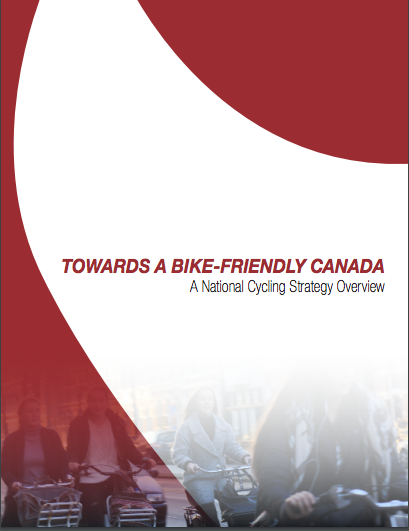CURRENT FEDERAL INITIATIVES
When the Trudeau government announced eligible projects for their Public Transit Infrastructure Fund, it marked the first time a federal government funded active transportation projects. Toronto received almost $42 million in federal funding for cycling projects such as the West Toronto Railpath extension, Eglinton Connects, and new bike share stations. Federal funding covers up to 50% of infrastructure costs – total Toronto projects come to $84 million – and projects must be shovel ready by March 31, 2018.
Further to federal funding, Transportation Minister Marc Garneau established a road safety task force last September. While more focused on heavy trucks, it plans to look into measures such as truck side guards; something the federal NDP had called for with Olivia Chow’s Bill C-344. Cycling infrastructure funding and a road safety task force are good steps, but need to be followed up with a national cycling strategy.
A NATIONAL CYCLING STRATEGY
Shortly after Toronto’s Bikestock in September 2014, then Parkdale-High Park MP Peggy Nash introduced Motion M-527 supporting the creation of a national cycling strategy. At that time, the motion called for a policy framework promoting cycling as a key part of transportation planning, introduction of legislation and funding measures, data collection, and dissemination of best practices. However, parliamentary motions only allow for debate and are not binding on the government.
Despite Nash losing her seat the following year, work on a national cycling strategy continued, which Toronto-Danforth MP Julie Dabrusin announced along with the pending formation of an all-party cycling caucus at Bells on Danforth in June 2016. The official launch for both initiatives happened last October, including the introduction of Bill C-312 by Courtenay-Alberni MP Gord Johns. During last month’s Winter Cycling Congress, Johns announced the bill would likely reach second reading sometime in 2018.
Compared to other OECD countries, Canada has been a laggard with their lack of a cycling strategy. Even in the United States – home of General Motors, Ford, and Fiat Chrysler – annual active transportation funding increased rapidly from $5 million to over $1 billion over a twenty-year period.[1] Upon reviewing the updated Dutch “Tour de Force” strategy, several components of effective strategies were identified.
1 – Clear Objectives – The Tour de Force calls for a 20% increase in cycling in the Netherlands by 2027.
2 – Diverse Stakeholders – In addition to governments, the Dutch strategy was developed with the NS railway company, Fietsersbond (Dutch Cyclists Union), Dutch Cycling Embassy, and CROW-Fietsberaad which developed their world-renowned transportation manual.
3 – Broad Themes – Cycling strategies often bring up arguments such as public health, climate change, cycle tourism, and supporting local economies. However, they must be backed by …
4 – Specific Goals – The Tour de Force identified eight goals to help achieve a 20% increase in cycling. These include improving integration between bikes and other transport modes and addressing theft.
To help make a Canadian cycling strategy a reality, we need a national voice for cyclists.
ENTER CANADA BIKES
Canada Bikes was established in 2012 at the Vélo-City conference in Vancouver. Groups such as Cycle Toronto are members, though individual memberships are also available. Last year, they launched the “Towards a Bike Friendly Canada” brochure calling for a national cycling strategy, as well as a cycling and walking funding proposal. The proposal called for $694 million annually; tiered based on the size of municipalities and a separate portion for infrastructure next to provincially managed rights of way.
To help reach out to the community and elected officials at all three levels of government, Canada Bikes organizes the annual Bike Day on the Hill. This year’s event – a National Bike Summit – will take place on June 1; coinciding with the Federation of Canadian Municipalities conference. With the Conservative and NDP leadership races under way, Canada Bikes issued surveys with Chris Alexander expressing support.
Canada Bikes is planning to launch a petition supporting a national cycling strategy, but it wasn’t ready at the time of writing. Stay tuned on their website for more updates.
UPDATE (2017/05/07) - Instead of a petition, Canada Bikes launched a fundraising campaign to help achieve their goal of a bike friendly Canada. If you donate $30 or more, you get an individual membership.
ONE MORE FEDERAL ISSUE
I will close this post with an initiative from Laurier-Sainte-Marie MP Hélène Laverdière. Her bill C-322 – which started second reading on Monday, March 20 and will resume on or after Tuesday, April 11 – would give Transport Canada the authority to order the construction of safe railway crossings. Upon reading the recent debate, the Liberals’ Karen McCrimmon opposed the bill claiming such tools already exist via the Canadian Transportation Agency, while the Conservatives’ Luc Berthold called for a broader approach. Until debate resumes, there is a petition supporting the bill which you can sign and share.
Let’s continue reaching out to cyclists across Canada in making our country safer to bike!
Rob Z (e-mail)
---
[1] John
Pucher & Ralph Buehler. 2012. City Cycling.
Page 24.


No comments:
Post a Comment